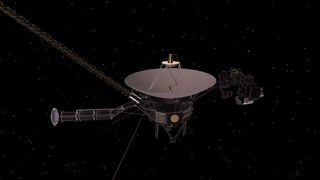Voyager 1 is back online! NASA's most distant spacecraft returns data from all 4 instruments
The spacecraft has resumed full science operations after a technical issue began creating complications in November 2023.

All right, everyone — we can all breathe a sigh of relief. NASA's Voyager 1 spacecraft is fully operational once more, with all four science instruments returning usable data to Earth.
The problems began in November 2023, when Voyager 1 lost its ability to "speak" with us. More specifically, it started sending to Earth unintelligible data instead of its normal 0s and 1s of binary code. Of course, Voyager 1 is 46 years old — ancient for a spacecraft — so it wasn't entirely a surprise that its health might be waning. And that's not to mention that it's in entirely uncharted interstellar territory, some 15 billion miles (24 billion kilometers) from Earth.
Voyager 1's dogged team was determined to not only figure out what went wrong, but also to fix the problem. And they've succeeded! Controllers identified where the issue was located: the flight data subsystem (FDS), used to "package" data to be sent to Earth. Further sleuthing revealed the exact chip causing the problem, which allowed them to find a workaround. After the team relocated the code to a new location in the FDS, Voyager 1 finally sent back intelligible data on April 20, 2024 — but only from two of its four science instruments. Now, just two months later, Voyager 1's remaining two science instruments are back up and running, communicating effectively with mission control on Earth.
Even if Voyager 1 had gone dark for good, however, the mission would still have been a wild success. After it launched in 1977, its primary mission was to study Jupiter and Saturn — that was accomplished by 1980. (Its twin spacecraft, Voyager 2, went on to study Uranus and Neptune.) But Voyager 1 is on an unstoppable path. Continuing its journey away from Earth, the spacecraft entered interstellar space in 2012, returning crucial data about this mysterious realm.
Now that Voyager 1 is back online, the team will continue to "touch up" the spacecraft to get it back in top form, including resynchronizing its timekeeping software to execute commands at the right time, as well as performing maintenance on the digital tape recorder that measures plasma waves. And hopefully, Voyager 1 will have a long, happy life ahead.
Get the Space.com Newsletter
Breaking space news, the latest updates on rocket launches, skywatching events and more!
Join our Space Forums to keep talking space on the latest missions, night sky and more! And if you have a news tip, correction or comment, let us know at: community@space.com.

Space.com contributing writer Stefanie Waldek is a self-taught space nerd and aviation geek who is passionate about all things spaceflight and astronomy. With a background in travel and design journalism, as well as a Bachelor of Arts degree from New York University, she specializes in the budding space tourism industry and Earth-based astrotourism. In her free time, you can find her watching rocket launches or looking up at the stars, wondering what is out there. Learn more about her work at www.stefaniewaldek.com.
-
richlightyear Having traveled 15 billion miles, it is now still only .0025 light years away. The universe is a pretty big place.Reply -
CrispyBokeh Oh, I didn't know. I thought it was pretty much at the edge of the universe already, and that space was tinyReply -
billslugg Voyager 1 is at the edge of the explored universe.Reply
Space is tiny until Dad makes you shuck enough sweet corn to fill a bushel basket. -
CrispyBokeh Reply
I was being sarcastic to the first comment. But also, no, it's not at the edge of the explored universe - unless you mean with a physical spacecraft. JWST has explored far further.billslugg said:Voyager 1 is at the edge of the explored universe.
Space is tiny until Dad makes you shuck enough sweet corn to fill a bushel basket. -
yossarian22 This is the energizer bunny of space crafts. It just keeps going and going even when NASA believes they have heard the last from it. Pretty good for a vessel with the computing power that's less than the average electronic car key of today.Reply -
NapmasterG Reply
Oh that’s just great…and my daughter’s name is Ailea…and she wants to be astronaut…DanielJ said:Except now it wants to be referred to as 'Vger'. -
Questioner Voyager 1 would be an excellent place to measure the orbit diameters of Solar system planets using its distances to and trigonometry with angles from the background stars.Reply
A fine place to differentiate if any discrepancies of distance occur from mass field internal frames of reference (we measure) and its more largely mass field external frame of reference.
Keep that 46 y/o puppy 'right now' relevant,
with informative experiments.
Come on people, let’s do some science. -
Jambo Bwana! Reply
That is awesome. I am a die hard star trekker.NapmasterG said:Oh that’s just great…and my daughter’s name is Ailea…and she wants to be astronaut… -
Questioner Do they have to speed up signal frequencies to communicate with Voyager 1 due to our time dilation so far inside to the Sun's mass field?Reply